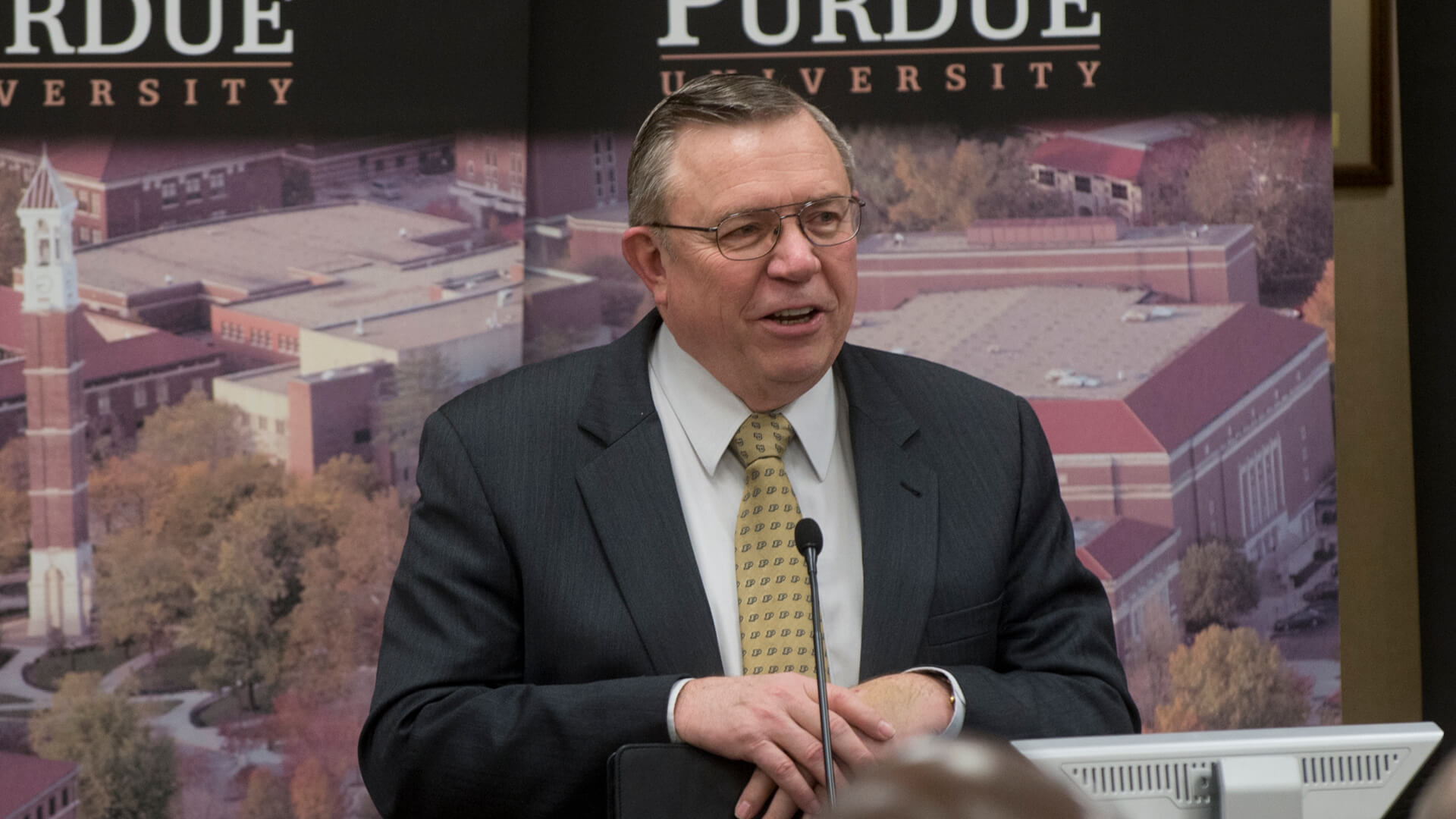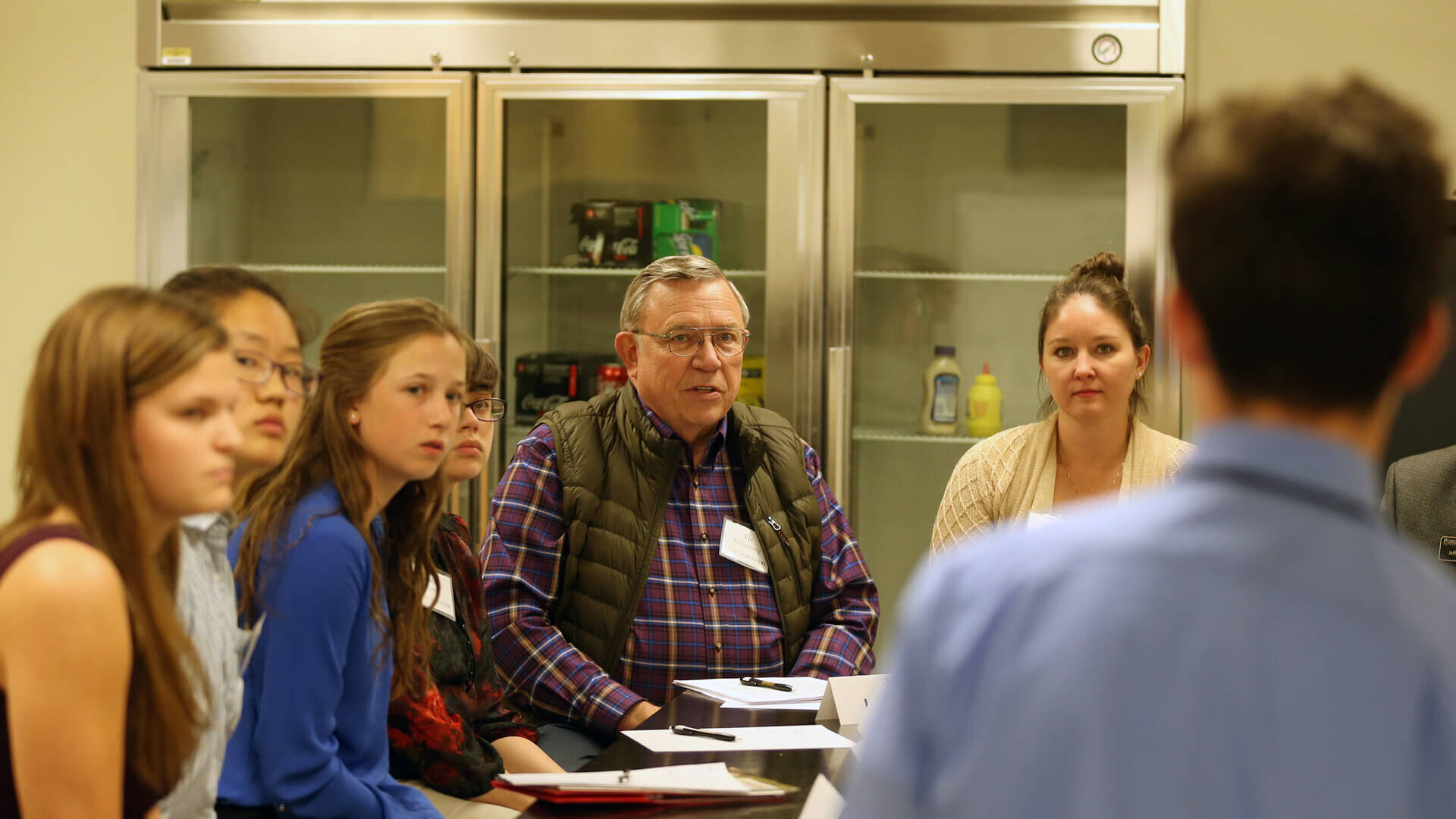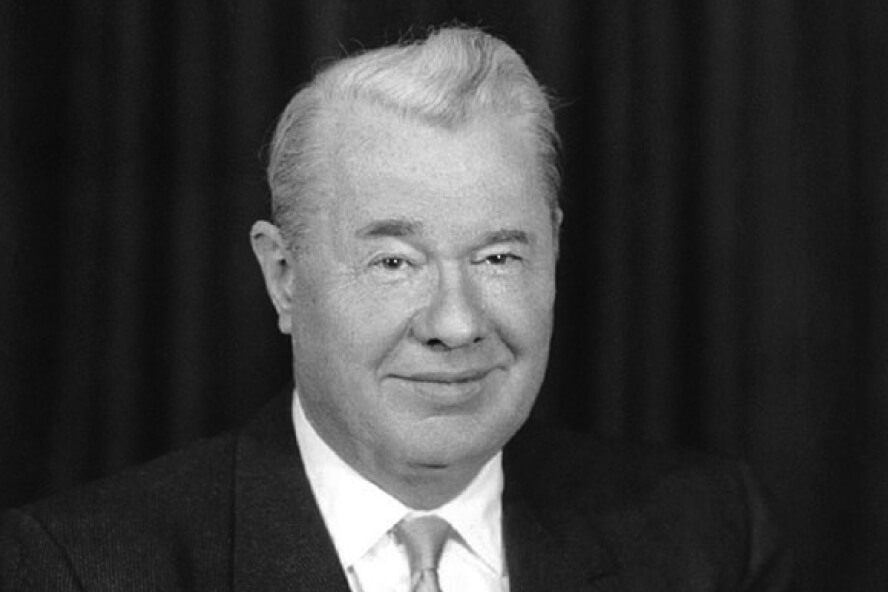Land-grant legacy came full circle for two Purdue leaders

Throughout his Purdue career, Vic Lechtenberg drew inspiration from the land-grant educational model that gave Vic and his six siblings opportunities to succeed. (Photo courtesy of Vic Lechtenberg, Purdue College of Agriculture)
Personal stories of former ag dean and financial officer marked by impact, ripple effects on community
Reflecting on conversations that occurred 60 years ago, Vic Lechtenberg recognizes the sly encouragement from his father that changed the course of his life.
It was in the fall of 1962 in northeast Nebraska, where Lechtenberg grew up on a livestock farm as the oldest of seven siblings. When his father picked Vic up from football practice one afternoon, he asked his son if he had applied to attend college yet.
Vic said that he hadn’t, and probably would not do so, to which his father replied, “Well, you ought to go one year just to see if you can do it.”
And so he did – to the University of Nebraska – his home state’s land-grant institution.
A year in, his dad encouraged him to stick around for another year so that he could earn a certificate for an associate degree. Once again, he followed his dad’s advice.
“By that time, I’d gotten acclimated, and I was getting pretty good grades, so I stuck it out,” Lechtenberg recalls.
As a teenager, Lechtenberg didn’t recognize what his father was up to, but the passage of time often provides insight that might not have been immediately evident.
You see, Lechtenberg’s parents grew up during the Great Depression. They viewed college as an opportunity for their children to build the knowledge to enjoy more prosperous lives – an opportunity they did not have. Lechtenberg’s mother had graduated from high school, but his dad only completed eighth grade.
“He got out of the eighth grade in about 1931 – the height of the Depression – and he stayed home to try to help get the farm through the Depression years,” Lechtenberg says. “I think he always felt that he was cheated out of an education. He never complained about it, but he was also bright enough to know that if he didn’t get the oldest of the kids to go to college, he probably wasn’t going to get the others.”

That’s how his subtle pressure campaign on Vic began, eventually ending with a 100% success rate. All seven siblings ultimately graduated from the University of Nebraska, where Vic earned a bachelor’s degree in agricultural education in 1967. Two of the siblings earned master’s degrees. Two of the Lechtenbergs have PhDs – one of whom is Vic, who completed a doctorate in agronomy and crop science at Purdue in 1971 before launching a career that spanned more than four decades in West Lafayette.
Lechtenberg started his Purdue tenure as an agronomy professor and later held such prominent positions as dean of agriculture (1993-2004) and vice provost for engagement (2004-11), as well as interim provost (2007-08) and interim vice president for government relations (2008-09). As co-founder and director of the Purdue Center for Regional Development, he was heavily involved in engagement activities that aimed to grow Indiana’s economy – an important facet of the university’s land-grant commitment to serve its home state.
That commitment is also at the heart of an event that exploded in popularity during Lechtenberg’s tenure as dean of agriculture. From its humble beginnings in the early 1990s, the College of Agriculture’s Spring Fest – which will be held this year on Saturday, April 15, from 10 a.m. to 6 p.m. – has grown to welcome tens of thousands of annual visitors who interact with displays and demonstrations from units across campus.
Lechtenberg praises Spring Fest pioneers like entomology professor emeritus Tom Turpin, founder of the legendary Bug Bowl, for building the event into an attraction that serves a greater purpose. Visitors of all ages are welcome at Spring Fest, but children are the true target audience. Not only do the fun, hands-on activities teach youngsters about the many different disciplines available on the Purdue campus, they also have an underlying goal of encouraging them to picture themselves as students at a university like Purdue someday.
In Lechtenberg’s view, his many years supporting outreach efforts to government agencies, corporations and communities across the state were simply his way of repaying the educational system that so benefited his family.
“All of us are well educated, and that’s only because of land-grant universities,” says Lechtenberg, who worked at Purdue under six presidents, from Frederick Hovde to Mitch Daniels. “If land-grant universities didn’t exist, none of us would have had a college education. We couldn’t afford it. So, do I have a passion for them? Yeah, I do, and I also have a strong personal passion that the education you get should be used to make things better.
“It’s not just for you. In my case, society invested in me. I should provide a return on that investment in some way. You do that by contributing to furthering the education, building the institution, building a society that you have the benefit of being a part of.”
Society invested in me. I should provide a return on that investment in some way. You do that by contributing to furthering the education, building the institution, building a society that you have the benefit of being a part of.
Vic Lechtenberg Former dean of agriculture and vice provost for engagement
Millions of success stories
As a young person, Lechtenberg had no understanding of the many ways that the Morrill Act – which in 1862 created the nation’s land-grant universities – had impacted his life.
He was unaware of the common purpose linking the farm-improvement projects that helped his father manage the family’s livestock with the educational programs that enriched his high school experience and crop science research projects he joined as an undergraduate student at Nebraska.
Nor did he realize that the Morrill Act’s revolutionary mission to open higher education to the American working class had created a pathway for his brothers and sisters to join him as college graduates.
Only later did he come to realize that the butterfly effect of one bill’s passage is that millions of Americans and thousands of Boilermakers have lived more fruitful lives, including one of the most influential administrators in Purdue’s 154-year history.
R.B. Stewart’s path to Purdue
Today, R.B. Stewart is remembered as Purdue’s chief financial and business officer from 1925-61 who oversaw exponential growth in the university’s enrollment, physical facilities and endowment, in addition to his stewardship of the nation’s G.I. Bill program.
But Stewart’s early start as the son of a poor lumberjack in Duluth, Minnesota, hardly indicated that he would someday guide one of America’s top public research institutions.
According to Ruth W. Freehafer’s “R.B. Stewart and Purdue University,” he borrowed $100 so that he and his new wife, Lillian, could move to Madison, Wisconsin, in 1918. He then took a job as an accountant at a local artillery company so that they could qualify as Wisconsin residents and pay much lower tuition rates to attend the University of Wisconsin, the state’s land-grant school.
This opportunity to obtain a practical, affordable education allowed Stewart to start a career and become an administrator that some Boilermakers believe “had a greater single impact on the institution’s destiny than any other individual in university history,” according to Freehafer’s biography.
When he spoke at the 1961 dedication of “The Spirit of the Land Grant College” mural in Purdue’s Memorial Center – renamed as the Stewart Center in his and Lillian’s honor in 1972 – Stewart shared what the Morrill Act meant to his own success.
“Without the land-grant colleges, I would be an uneducated man,” he said. “… Land grant is the priceless heritage of America, more typical of America than any other education act – the only truly American contribution to education.”
Without the land-grant colleges, I would be an uneducated man. … Land grant is the priceless heritage of America, more typical of America than any other education act – the only truly American contribution to education.
R.B. Stewart Former chief financial and business officer
A truly American system
During his time as dean of agriculture, Lechtenberg came to understand just how American the land-grant model actually was. After the Iron Curtain fell, Lechtenberg met with numerous Eastern European university administrators who marveled at the way land-grant universities like Purdue handled their commitment to educate, conduct research and then share university knowledge with the public.
Frequently, those countries would have universities dedicated to teaching, others that were dedicated to research and local agencies that conducted extension work. However, those three were intentionally not housed under one leadership umbrella, as with American land-grant universities, nor did they communicate effectively.
Sometimes Lechtenberg would further mystify these administrators by explaining that the U.S. system’s success was a happy accident. The Morrill Act introduced land-grant institutions in 1862, but their research mission did not officially enter the picture until the passage of the Hatch Act in 1887. Engagement work became part of the land-grant equation with the Smith-Lever Act of 1914.
It took the better part of a century following the passage of the Morrill Act for the three prongs of the land-grant mission to begin functioning in concert.
“If there had been a grand plan, it wouldn’t have been rolled out over 50 years,” Lechtenberg says. “You’d have done it a lot quicker than that.”
But even if what we now refer to as the land-grant mission was assembled by accident, the Morrill Act’s impact on the U.S. educational system and economy is nonetheless immeasurable.
A decade before the Morrill Act passed, 85% of the U.S. population lived on farms, but most agricultural innovation was occurring overseas. The 1860 U.S. Census revealed that only 3% of American colleges and universities had units that offered studies in agriculture or science.
The nation needed to train its farmers to do their work more efficiently, and it needed engineers to construct the infrastructure necessary to serve an increasingly industrialized society. This is why the text of the Morrill Act specifically instructs land-grant institutions to focus on instruction in agriculture and the mechanic arts (engineering) alongside scientific and classical studies.
In 1866, approximately 300 Americans possessed a degree in engineering. By 1911, U.S. universities were churning out 3,000 engineering graduates per year, and there were 38,000 degreed engineers across the country.
“Today, we have the greatest agricultural system in the world,” says John Norberg, who is writing his ninth book about Purdue and its history. “We have enough food to feed our country. We may not get it to everyone, but we produce enough food, plus we supply the rest of the world with stuff, too.
“Why did that happen? It happened because land-grant universities like Purdue went out into the communities, to the farmers, and taught them how to farm better – and we’re still doing it. We have programs helping farmers in every county in the state of Indiana. If the farmer has problems, he can go see the county agent. Who’s the county agent? He’s a Purdue person. We’re still active in that today, and we also transformed engineering, factories and industry.”

An enduring mission
Through the years, Lechtenberg has occasionally heard questions about whether land-grant universities remain necessary. The U.S. has numerous engineers today, and farmers are no longer at the bottom of the economic spectrum. Many who work in either profession actually do quite well financially. If these are the working-class people the Morrill Act was designed to support, does that mean its mission is complete?
“My reaction to that is you misread the Morrill Act,” Lechtenberg says. “It’s true that it said agriculture and mechanic arts, but those were the downtrodden classes of the day. If you read it more broadly and say it was intended to provide educational opportunities for the economically disadvantaged, we still have those segments today in spades.”
Today, Purdue has expanded the educational opportunity it offers via Purdue Polytechnic High Schools, which provide pathways to college for underrepresented students, and Purdue Global, which allows adult learners to obtain online college degrees that can expand their career horizons.
Lechtenberg applauds these efforts, noting that Purdue’s responsibility to serve those students is the same as its founding commitment to provide educational opportunity to the nation’s future farmers and engineers.
“In a lot of ways, they’re achieving much of the same mission that the Cooperative Extension Service did in the 1920s,” he says. “It’s not agriculture, but what they’re doing is taking Purdue know-how and educational capabilities to a segment of society that otherwise wouldn’t be able to participate. They don’t have to be concentrated on farms. They’re in other pockets of the social network.”










